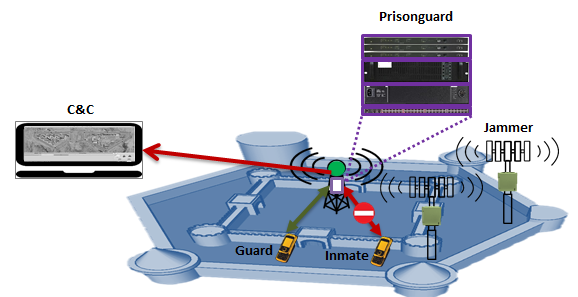Controlling the communications inside the prison
The introduction of smartphones to the world in the last years has brought with it growing connectivity but ales, it also provided terrorists and criminals a better capability to conduct their nefarious activity. Concretely, in the last few years there is a surge of smuggling cellular devices into prisons all over the world. Even worse, inmates are taking pictures or videos of their activity in prisons and uploading it to the internet, causing much dismay to prison authorities.
Cellphones has also provided a means and an opportunity for prison breaks.
different prison solutions:
a. Solution A – Jamming solution only
b. Solution B – Jamming solution but providing prison guards ability to conduct phone calls.
c. Solution C – the Managed Access approach (selective blocking and voice call interception).

Solution A – Jamming Only Solution
The jamming solution provides continuous jamming of all relevant communications in a pre-defined area inside the prison. The bands and areas to be jammed are according to customer requirements.
Key benefits to the customer:
• Advanced technological solution but with simple deployment
• Jamming all types of communications
• Cost effective solution
• Doesn’t impede outside the prison communications
• Adjustable and scalable – adding bands that needs to be jammed is usually easy to do
Solution highlights
prison solution is based on the jamming of the following:
a. Cellular technologies such as GSM/UMTS/LTE, in all cellular standards such as HSPA, CDMA and more.
b. Wi-Fi jamming – jamming both frequencies of 2.4 and 5.8 GHz
c. Satellite jamming – if required by the customer
Notwithstanding, The solution can provide (optional) RF filters that allow:
a. Prison guards DECT communication (PTT)
b. Prison guards cellular communication (sometimes through dedicated cellular or Wi Fi antenna).

Solution B – Jamming communications while providing prison guards communication
Solution B does not differ greatly from solution A but the fact that we will provide dedicated BTS’s in GSM so that prison guards would be able to conduct phone calls everywhere in the prison. our uniqueness lies in its ability to combine between jamming and the ability to provide prison guards the ability to conduct voice calls communications in GSM.

Solution C – jamming and providing cellular phone calls interception
Solution C is the more complicated solution between the three different solutions but it holds an intelligence value for the customer. At the core of this concept is the Managed Access approach which is explained hereafter.
Concept of Operations – the Managed Access approach
The system provides the Managed Access approach to the customer. This enables prison authorities to control the communications inside a prison, decide which of the illegal communications conducted from prison a target for intelligence collection (IMSI and interception) and which targets are to be blocked and deny them of access to the real cellular network. This approach, named also ‘selective blocking’, creates two lists of targets, ‘black list’ which are usually the list of illegal smuggled phones and a ‘white list’ of prison guards cellular devices that are continuing to conduct their regular communications (cellular or any other) unimpeded.
It is important to emphasize that some bands (according to customer requirements) will be alternately jammed in order to provide better efficiency for the PrisonGuard system.
Benefit for customer:
a. Control all communications inside the prison
b. Provide cellular identities of illegal phones
c. Create target list (‘black list’) for continuous intelligence collection
d. Block/jam all required communications including Wi-Fi communications
e. Prevent RF leakage
f. Allow regular communications to prison guards
g. Detection of cellular devices
Method of operations
The Prison Guard solution works in the following manner:
a. The jammers block UMTS/LTE and Wi-Fi communications and allow prisoners to use their cellular devices only in GSM. It is also possible to conduct IMSI catching in 3G and 4G.
b. All prison guards cellular devices will be ‘white listed’, meaning that their communications will not be impeded.
c. Once working on GSM, the PrisonGuard system will provide the following:
1) IMSI
2) IMEI
3) TMSI
4) Rx level
5) Tx level
6) Additional information
d. Operator decides which calls are intercepted and which are not. In any case, all IMSI/IMEI’s inside the prison are collected all the time.
e. System operator can add targets to the system on a regular basis.
